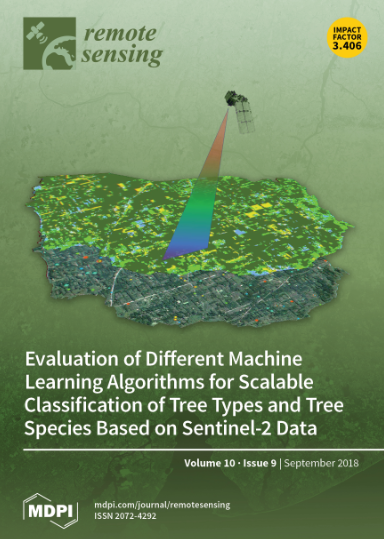基于遥感数据的植被与土壤水分异常之间的关系:半干旱牧场案例
IF 4.2
2区 地球科学
Q2 ENVIRONMENTAL SCIENCES
引用次数: 0
摘要
牧场的动态变化源于植被、土壤、气候和人类活动之间复杂的相互作用。在这种情况下,牧场状况的监测具有挑战性,在研究放牧压力时应仔细考虑退化评估。在本研究中,我们利用植被和土壤水分指数研究了半干旱牧场植被和土壤水分的相互作用。我们旨在研究利用土壤水分负异常作为植被或农业干旱预警指数的可行性。这项研究选择了西班牙的两个半干旱农业地区:Los Vélez(阿尔梅里亚)和 Bajo Aragón(特鲁埃尔)。采集了 2002 年至 2019 年空间分辨率分别为 250 米和 500 米的 MODIS 图像,分别根据归一化差异植被指数(NDVI)和土壤水分分量(W)计算植被状况指数(VCI)和水分状况指数(WCI)。光学梯形模型(OPTRAM)估算了后一种 W 指数。由此计算出每个指数的异常值(Z 值),分别为 ZVCI 和 ZWCI。每 10 天(10 天周期)计算一次它们的负异常重合概率。结果表明,在特定月份,ZWCI 很有可能提前预报 ZVCI 负值将下降的情况。在气温较低的月份(秋季至春季),土壤含水量和植被指数显示出更相似的动态。在这些月份,由于气温较低,降水导致植被生长。在接下来的月份里,随着气温的升高和降水量的减少,水分供应量取决于蒸散量和植被类型。从秋季到春季开始,植被与降水之间的关系更加密切,这反映在 ZWCI 预测 ZVCI 的可行性上。在这几个月中,将 ZWCI 作为预警指数在所研究的两个地区都是可行的。值得注意的是,从 11 月到 2 月初,植被异常的可预测性平均提高了 20%-30%,提前四个滞后期知道湿度土壤异常。我们还发现其他可预测性增加的时期,如洛斯韦莱兹的 3 月和 4 月,以及下阿拉贡的 7 月至 9 月。本文章由计算机程序翻译,如有差异,请以英文原文为准。
Relationship between Vegetation and Soil Moisture Anomalies Based on Remote Sensing Data: A Semiarid Rangeland Case
The dynamic of rangelands results from complex interactions between vegetation, soil, climate, and human activity. This scenario makes rangeland’s condition challenging to monitor, and degradation assessment should be carefully considered when studying grazing pressures. In the present work, we study the interaction of vegetation and soil moisture in semiarid rangelands using vegetation and soil moisture indices. We aim to study the feasibility of using soil moisture negative anomalies as a warning index for vegetation or agricultural drought. Two semiarid agricultural regions were selected in Spain for this study: Los Vélez (Almería) and Bajo Aragón (Teruel). MODIS images, with 250 m and 500 m spatial resolution, from 2002 to 2019, were acquired to calculate the Vegetation Condition Index (VCI) and the Water Condition Index (WCI) based on the Normalised Difference Vegetation Index (NDVI) and soil moisture component (W), respectively. The Optical Trapezoid Model (OPTRAM) estimated this latter W index. From them, the anomaly (Z-score) for each index was calculated, being ZVCI and ZWCI, respectively. The probability of coincidence of their negative anomalies was calculated every 10 days (10-day periods). The results show that for specific months, the ZWCI had a strong probability of informing in advance, where the negative ZVCI will decrease. Soil moisture content and vegetation indices show more similar dynamics in the months with lower temperatures (from autumn to spring). In these months, given the low temperatures, precipitation leads to vegetation growth. In the following months, water availability depends on evapotranspiration and vegetation type as the temperature rises and the precipitation falls. The stronger relationship between vegetation and precipitation from autumn to the beginning of spring is reflected in the feasibility of ZWCI to aid the prediction of ZVCI. During these months, using ZWCI as a warning index is possible for both areas studied. Notably, November to the beginning of February showed an average increase of 20–30% in the predictability of vegetation anomalies, knowing moisture soil anomalies four lags in advance. We found other periods of relevant increment in the predictability, such as March and April for Los Vélez, and from July to September for Bajo Aragón.
求助全文
通过发布文献求助,成功后即可免费获取论文全文。
去求助
来源期刊

Remote Sensing
REMOTE SENSING-
CiteScore
8.30
自引率
24.00%
发文量
5435
审稿时长
20.66 days
期刊介绍:
Remote Sensing (ISSN 2072-4292) publishes regular research papers, reviews, letters and communications covering all aspects of the remote sensing process, from instrument design and signal processing to the retrieval of geophysical parameters and their application in geosciences. Our aim is to encourage scientists to publish experimental, theoretical and computational results in as much detail as possible so that results can be easily reproduced. There is no restriction on the length of the papers. The full experimental details must be provided so that the results can be reproduced.
 求助内容:
求助内容: 应助结果提醒方式:
应助结果提醒方式:


